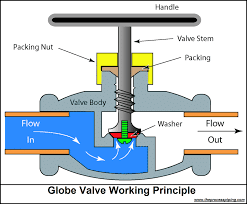Globe Valve is amongst the most widely encountered valves. They are linear motion valves designed to isolate and regulate the flow of the medium. In comparison to other types of valves, they can provide better shut off, proper sealing, and faster operation. The ease of maintenance of globe valves makes it particularly suitable for services which require frequent valve maintenance in most of the fluid handling process.
Construction of Globe Valve
A typical globe valve with flanged ends is illustrated in Fig below. They usually have rising stems, and the larger sizes are of the outside screw and yoke construction. They have a specific direction for fluid flow. Depending on the application, the fluid flow can be above or below the disc.
Major Components of the globe valve are
- Valve Body: Complete body of the valve
- Wheel and nut: For the manual operation of the valve.
- Gland Packing: To prevent leakage from the stem.
- Stem: To connect the disc to the valve actuator
- Bonnet – Outer part of the valve
- Disc/Valve – Moveable physical barrier that goes up and down to regulate the flow.
- Valve/Disc Seat – Valve disc is tightly pressed against the seat to stop the flow of fluid.
Types of Globe Valves:
They can be classified depending on various parameters.
In general, the valve is identified as per the design of the valve body as given below:
- Standard (T or Z) Pattern: This is the most common type of valve in which the stem and disc travel perpendicular to the direction of fluid flow.
- Angle Pattern: In this type of valve there is a change in the direction of fluid flow by an angle of 90 degrees.
- Oblique (Wye or Y) Pattern: In this type of valve the seat and stem are angled at approximately 45 degrees which offers less resistance to flow.
Alternatively, they can also be classified depending upon
- Design of Valve Disc: Conventional or Ball disc, Composition disc, and Plug type disc.
- Disc–Stem configurations of Valve: Rotating Stem with Integral or Non-Integral Disc and Non-Rotating Stem with Integral Disc or Non-Integral Disc.
- Valve Stem Screw: Inside and Outside stem screw.
- Bonnet Design of Valve: Bolted Bonnet, Welded Bonnet, Flanged Bonnet, Union ring Bonnet, and Pressure seal Bonnet
Uses of Globe Valves:
These valves have a large range of applications in various industries like shipbuilding, petrochemicals, pharmaceuticals, aerospace, etc.
- They are often used to regulate the flow of medium in cooling water systems, fuel oil systems, etc.
- They are considered most suited for applications where leak tightness and safety are major concerns like High-point vents and low-point drains.
- Globe valves are extensively used in control circuits due to their design for controlling a wide range of flow and pressure drop.
- Its reliability in withstanding a wide range of temperatures and pressures makes it suitable for use in a high-pressure system like steam, hydraulics, etc.
- The automation industry widely uses globe valves due to the ease of installation of automatic actuators.
For highly toxic mediums, bellows valve should be used.

